Menu
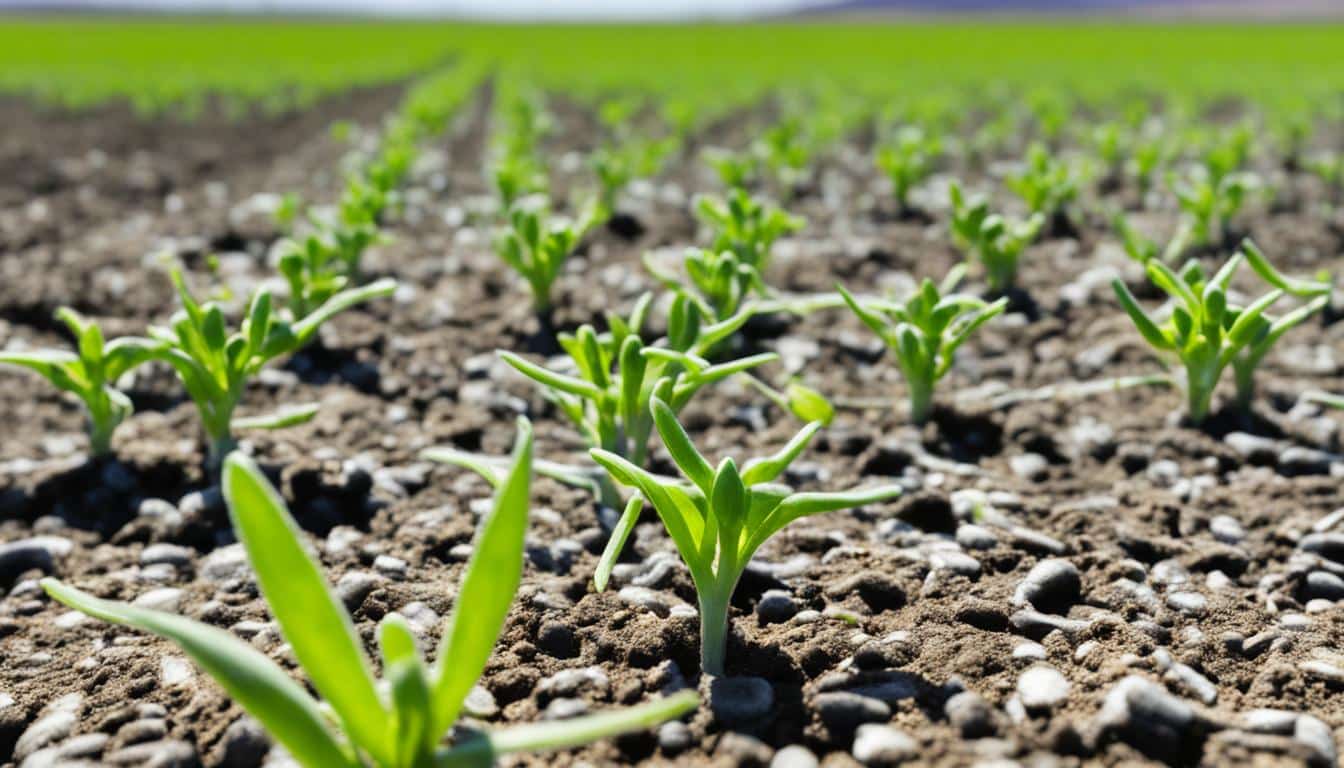
Did you know that global losses to plant diseases and pests range from 11-30%? These numbers go even higher in places with food shortages. With nearly 10 billion people to feed by 2050, we must increase food production by 60%. Biotech crops play a key role by fighting off pests and diseases.
According to the Department of Food and Rural Affairs, we need sustainable agri-solutions as more people come on the planet. Experts like Diouf and groups like the Royal Society stress the use of science to boost farming without harming the planet. Biotech crops, like Bt cotton, have shown they can beat plant diseases. This proves their worth in making farming more productive.
The story of biotech crops shows how plant science and engineering come together. This mix is vital for meeting our growing food needs. Thanks to new agricultural tech, we are hopeful for a future where we can eat without depleting the earth.
Let’s talk about biotech crop resistance introduction. It’s about changing plants genetically. This helps plants fight off bugs and diseases. The technology, as discussed by Springer-Verlag, is key in making plants tougher.
Rachel Carson’s book “Silent Spring” in 1962 warned about pesticides. It brought up the need for better ways to protect crops. GMO crops were then explored. They have built-in protection against pests. So, they are a big step in farming science.
Many studies show the good in GM crops. The use of Bt cotton in China, for example, cut down on pesticides. This both helped the environment and increased harvests. So, these crops offer a real alternative to harmful pesticides.
Research also says GM plants are safe and work well. Plants with Bacillus thuringiensis as protection, for insect pests are a good example. That’s according to Regulatory Toxicology and Pharmacology in 2000. It shows how GM solutions can truly help in farming today.
| Aspect | Impact |
|---|---|
| Bt Cotton in China | Reduced pesticide use, increased yield |
| Crop Loss by Nematodes | $7 billion annually in the U.S. |
| Head Blight in Wheat and Barley | $3 billion in damage (1991-1996) |
Genetic modification boosts crop resistance in an essential way. It lets scientists transfer helpful genes from other species to crops. This makes the crops stronger against pests and diseases, which helps our farms produce more food.
Scientists use many methods to make crops tough against threats. They might move defence genes from different creatures to our food plants. By doing this, they interrupt how pests work. This was explained by Gatehouse in 2008 and de Maagd et al. in 2001.
Also, using Bacillus thuringiensis (Bt) can stop pests, as found by Cannon in 1996 and Waltz in 2009.
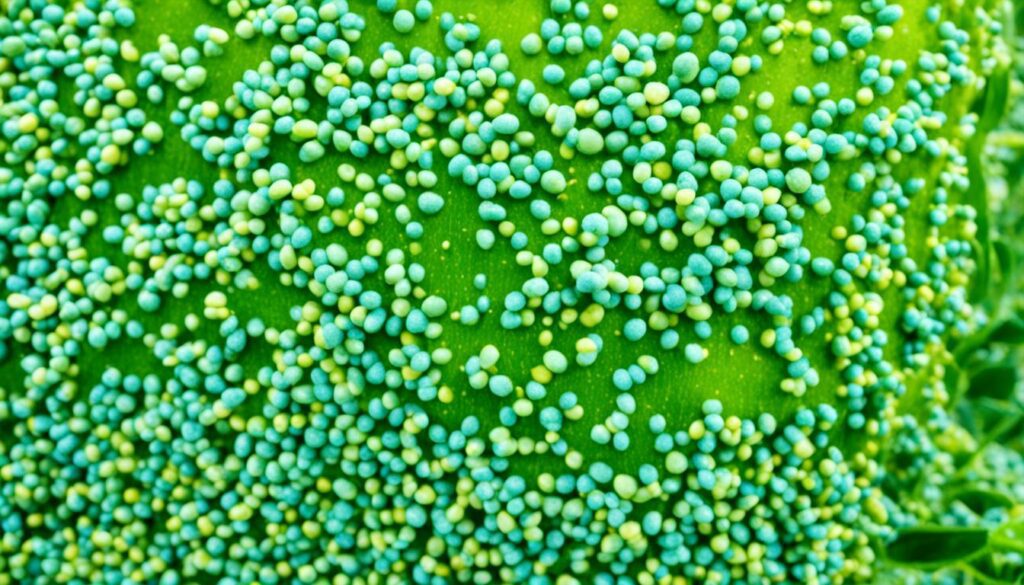
Modified crops like Bt cotton and virus-resistant papaya show how useful genetic changes are. Bt cotton defends itself from pests without needing as many chemical sprays. This helps the environment. Virus-resistant papaya stops destructive plant diseases, ensuring better harvests and steady food.
Research, such as the works of Alberts et al. (2013), shows a big support for genetically modified crops. They highlight the benefits for both farming and society. This was looked into by Mannion and Morse in 2013.
| Genetic Engineering Technique | Application | Impact |
|---|---|---|
| Gene Transfer | Transferring resistance genes from other species | Enhanced pest and disease resistance |
| Pathway Disruption | Disrupting biological pathways in pests | Increased resilience against pests |
| Bt Utilisation | Using Bacillus thuringiensis | Effective pest control |
| Virus Resistance | Developing virus-resistant crops | Stable and higher yields |
Using genetic changes in crops isn’t just about science. It’s crucial to meet the global need for more food and better farm practices. This tech is vital for food safety and less farming harm to our planet.
Biotech crop resistance is key in solving the world’s food security issue. Around 854 million people worldwide don’t have enough to eat. Advanced farming techniques are vital to ensure stable and sustainable crops. Disease-resistant crops are needed to survive tough conditions.
Golden Rice fights Vitamin A lack, affecting 140 million kids. It has saved thousands from blindness. The biotech field is making crops that yield more and are healthier, aiding global food security.
Biotech crops have boosted farm earnings, as seen with Bt cotton in India. They increased yield by 31% and cut insecticide use by 39%. This meant more profit, around $250 more per hectare. It shows why we need to keep investing in making crops disease-resistant.
They’ve also cut down on pesticides. In 2012, 88% of US’s corn, and over 90% of cotton and soybeans were biotech. This led to less need for pesticides, which makes crops safer.
Biotech is key in fighting plant diseases, like the one that almost ruined Hawaii’s papaya. It’s also helping in the fight against climate change. Biotech is keeping agriculture strong and able to feed the world.
| Indicator | Statistics |
|---|---|
| Undernourished Population | 854 million (12.6%) |
| Children with Vitamin A Deficiency | 140 million |
| Blindness Due to Vitamin A Deficiency | 250,000 to 500,000/year |
| Bt Cotton Yield Increase (India) | 31% |
| Bt Cotton Insecticide Use Reduction (India) | 39% |
| Biotechnology Plantings (US, 2012) | 88% corn, 94% cotton, 93% soybeans |
With agriculture changing fast, biotech crop resistance is now more important than ever. We must keep focusing on making crops that can survive climate change. This will make sure we can feed a growing world population.
It’s key to know the ways crops fight off pests to improve farming. Important studies show that looking at how living things resist bugs and finding special defence genes are big steps. This work, with plants like Arabidopsis and tomato, has really moved our knowledge forward.
Plants protect themselves against pests with detailed processes. They sometimes turn off genes to do this. These findings in Arabidopsis (Escobar et al. 2001) have given us insights into how plants say ‘no’ to bugs that aren’t usually their problem. By understanding these plant processes, we’re getting better at beating pests.

The very heart of how crops resist pests lies in their genes. With hard work on tomato and Arabidopsis, we’ve learnt so much about these genes. Studies by Narusaka et al. (2009) and Lacombe et al. (2010) have found key genes. These genes make plants fight off bugs and illnesses better. They’ve helped make crops stronger against pests.
The benefits of finding resistance genes can be seen worldwide. In Brazil, for example, some bugs have become immune to a special toxin in certain crops. But by adding resistant genes to crops, their power to fight bugs has grown stronger.
In India, there’s been a problem with pink bollworms becoming immune to a type of toxin. This issue shows us that we always need to keep looking for new ways to fight pests.
Corn in the southern US has shown great results against local bugs thanks to special proteins. This success with resistance genes tells us the efforts are truly worth it in different parts of the world.
Genetic engineering has changed the game in crop protection. Farmers and our planet benefit a lot. With these genetically modified crops, farmers can grow more and use fewer chemical pesticides. This way, farming is more sustainable and profitable.
Take Bt cotton, for example. It’s designed to fight off insects on its own. Because of this, farmers use fewer pesticides. In the U.S., the growth of these crops has cut down on synthetic pesticides. This helps keep our water clean and nature safe. In 2012, most of our corn, cotton, and soybeans were engineered this way, showing how big this change is.
But the benefits aren’t only about the environment. These advancements also help grow more food. Herbicide-tolerant crops, such as soybeans, let farmers use safer weed killers. These don’t stay in the soil or harm animals. Their use also stops soil from eroding. Crops like the Rainbow papaya protect industries from diseases, keeping production steady.
Overall, genetic engineering is key in today’s farming. It helps get more food and keeps our environment safer.
The Bt cotton case study shows how biotech crops fight pest resistance. Bt cotton has cut the need for chemical insecticides. This saves money and helps the environment. Research, such as studies by Pray et al. (2001) and Huang et al. (2003), shows big boosts in crops and money earned.
In China, Bt cotton lowered the use of pesticides by 78%, making nature better and pests fewer (Pray et al., 2002). Cattaneo et al. (2006) found that Bt crops outperformed normal crops against pests. They used fewer chemicals and did better for the planet.
Bacillus thuringiensis makes Bt cotton safe and good at keeping pests away. Betz et al. (2000) say Bt crops are great because they fight pests without harming nature or health.
Bt cotton targets specific pests, reducing the need for many insecticides. This helps good bugs thrive. Mulligan et al. (2006) found Bt cotton is better for the environment than traditional methods.
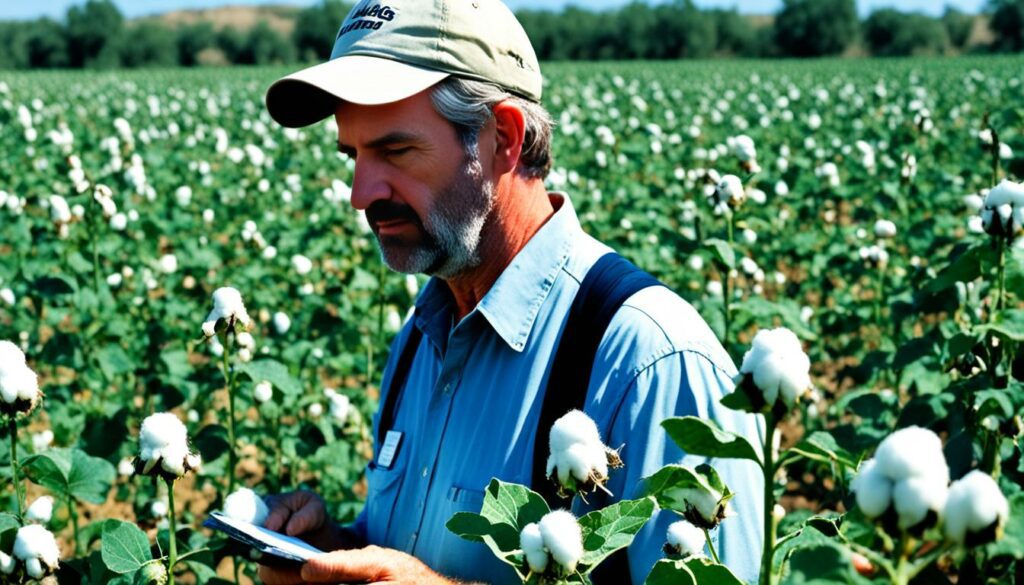
In short, the Bt cotton case study highlights the power of biotech crops. They help us grow more food while being kind to the earth. Biotech crops are the future of fighting pests in farming.
Developing crops that can resist diseases and pests is a big challenge. It’s not just about dealing with bugs, it’s also about taking care of the environment. We have to manage these things well to keep farming healthy and sustainable.
The effect on the environment is a big deal when creating resistant crops. Things like not enough water can lead to 70% of lost possible crops worldwide. This problem is even worse in dry places and in countries that are just starting to grow. Plus, bad weather might turn a lot of land that’s somewhat useful for crops into places that can’t grow anything.
Creating resistant crops can also mess up natural balance. For example, some crops that fight off pests might upset the wildlife around them. Making farming use water better is key. It helps to grow enough food without harm to the environment.
Bugs and diseases that can resist our crops are a big issue. They cause up to 30% of crop losses worldwide. Places that already struggle to feed their people are hit the hardest. For example, some areas see a lot of damage from:
To fight back, we use methods like moving resistance genes from one plant to another. We also change how these genes work. But soon, we need to find ways for crops to handle more than one problem at a time. And we must get approval to test these changes in fields. Adding genes to help crops survive drought has already made a difference. These crops yield 15-25% more than normal plants.
Plant science is key in making life better for everyone. It helps solve the big problem of not having enough food. By changing crops at their genetic level, they can fight off diseases and pests better.
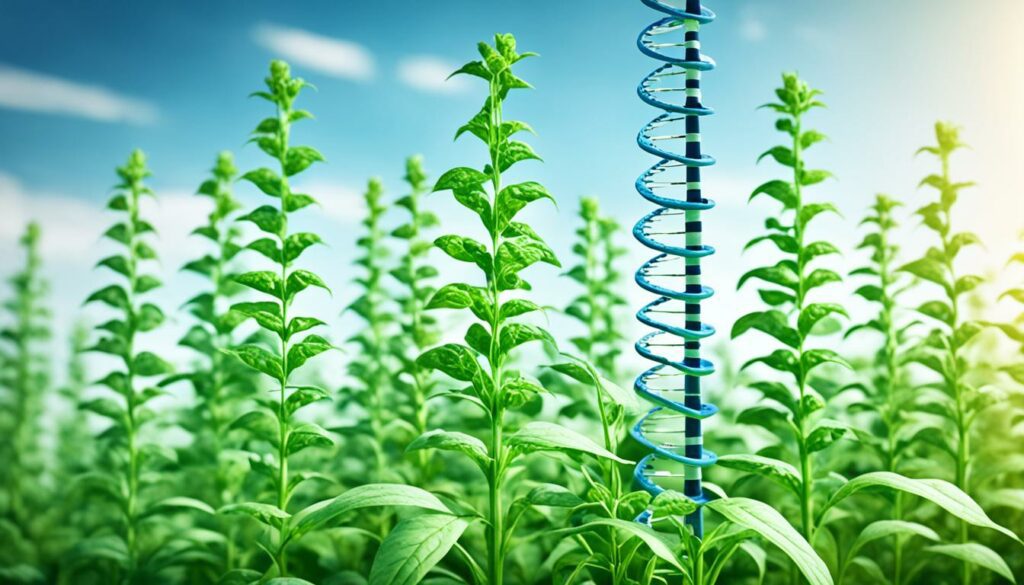
The USDA collects a lot of information about crops that use biotechnology. In 2012, many crops in the U.S. were produced using these techniques. This shows just how crucial plant science is in making our food supply better.
Every June, the USDA gathers information about crops from all states. They’re not alone in this work. Groups like ISAAA also help by studying the data. Their work helps show the progress we’re making in changing the genes of crops.
Despite our efforts, there’s still not enough food for everyone. Plant science is working hard to change this. We need to produce more food by 2020 to feed the extra 1.5 billion people who will be on Earth.
Crops face a lot of threats like diseases, pests, and weeds. Losses from these issues add up to a lot of money. The U.S. alone loses billions every year to crop diseases. Plant scientists aim to find better ways to protect crops, without harming the environment.
Plant science is deeply important for our future. By using genetic tools on crops, we can make farming more productive. This way, we can grow more food without harming the planet.
Integrated Pest Management (IPM) and Insect Resistance Management (IRM) strategies are very important. They help us deal with pests getting resistant to GM crops. These strategies mix old and new ways to keep pests under control. This makes our efforts in agriculture last longer without hurting the environment.
Mixing traditional farming with biotechnology in IPM methods is smart. It helps us use the best of both to fight pest resistance. Studies show that using GM crops to protect against insects has boosted crop yields by 22%. It also slashed the use of insecticides by 37%. Most importantly, it increased farm profits by 68%. This means we can enjoy the benefits of GM while keeping our old farming practices like changing crops and using helpful insects.
IRM plans have worked well in places dealing with pest resistance. In North America, these plans are a must and have been key in preventing pest problems in GM crops. They involve using GM crops with different protective traits and setting areas aside for pests. This way, we slow down how fast pests can get used to our GM solutions. For example, pests might resist these crops after about six years. But, some pests can still be controlled by these GM crops for more than a decade!
In the larger plan of IPM, GM crops like Bt cotton are also designed to protect themselves from pests. They help us use less chemical pesticides. This is good for the earth and makes our pest control methods last longer. Not only does this keep GM technology valuable and reduce our pesticide intake, it also makes our food safer for everyone.
Despite being used for nearly 25 years, only 19 cases of pests becoming resistant to specific Bt crops have shown up around the world. These cases involved just five main kinds of pests. This low number shows how effective combining IRM with IPM is. It’s proof that these methods really work.
Biotech crops really change how farming works nowadays. They make life better for farmers in many ways. For example, Bt cotton doesn’t just give more crop; it also cuts down on the need for expensive bug sprays. This all leads to more money in the farmers’ pockets and shows transgenic crop economics are key for future farming.
In 2012, nearly all new corn, cotton, and soy plants in the US were biotech ones. This big use of biotech crops shows how popular and helpful they are. The USDA‘s National Agricultural Statistics Service and the ISAAA share data to prove this point. They also show that globally, many farmers choose biotech crops.
Looking at profits from GM crop profitability, studies find big increases in how much is harvested. There’s also a big drop in the need for bug spray, which can save farmers a lot of money. Reports from the International Journal of Biotechnology and Agbioforum show how widespread and positive these effects are.

The USDA in particular gives lots of details about how biotech plants, like corn and soy, affect the economy. These details are very useful for both farmers and people who make decisions about farming. They show how using biotech can make farming both more profitable and better for the planet.
There’s good news from different countries too. Studies in Romania and Brazil, for example, show big increases in profits from some types of biotech crops. Places like Australia and Canada see the same with certain plants. All this research strengthens the story of transgenic crop economics.
Genetically engineered crops are changing agriculture, bringing in more crops, saving on costs, and making more money. This proves that not only are biotech crops science’s future, they’re also good for business in farming.
The world of future prospects in biotech is full of new ideas and breakthroughs. These tools and methods aim to change farming for the better. In the USA in 2012, a lot of crops like corn, cotton, and soybeans were biotech. They made up a big part of what farmers planted.
RNA interference (RNAi) is a big step forward in keeping crops safe from pests. It targets bugs that harm plants without needing harsh chemicals. This method shows how much we can transform crops with science. By using less chemical pesticides, it also helps the environment.
Plants that can handle herbicides better, like some soybeans, cotton, and corn, show the power of genetic science in farming. They let farmers use chemicals that are safer for people and nature. For example, genetically modified (GM) papayas not only saved their industry but also show how GM plants can be very useful.
We’re also working to make soybeans safer for everyone to eat. Scientists are removing things from them that can be harmful. They’re also making soy more nutritious. This work shows how we’re always getting better in innovations in agricultural biotechnology.
| Biotechnology Impact | Benefits |
|---|---|
| Insect-resistant crops (e.g., Bt cotton) | Reduced pesticide use, environmental benefits |
| Herbicide-tolerant crops | Safer herbicide usage, improved weed management |
| RNAi-mediated protection | Targeted pest control, decreased pesticide reliance |
| Genetically engineered papayas | Rescued industry, virus resistance |
Looking ahead, the field of biotech and its work in agricultural innovation offer great hope. They aim to tackle food and sustainability challenges. With genetic engineering, we’re getting closer to a farm system that’s stronger and more productive.
In the complex debate of chemical controls vs genetic engineering, it’s vital to look at their effects. They differ in how they affect our environment and can sustain themselves over time. The world loses a lot of crops to diseases and pests every year. This is biggest in areas where people already struggle to get enough food. Chemical controls are the traditional answer, but genetic engineering offers a new and exciting alternative.
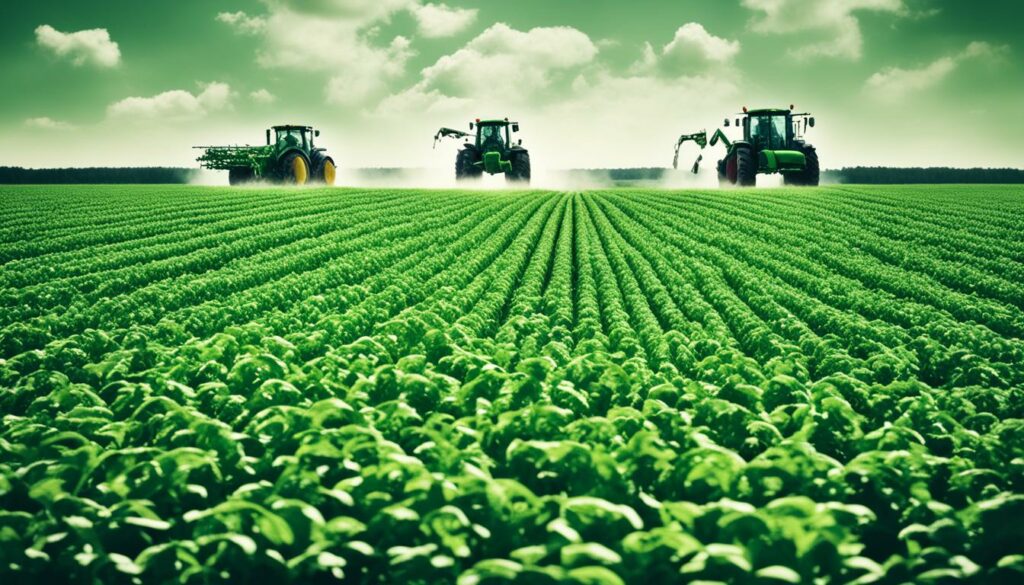
The past is full of stories like the Irish potato famine and the Sri Lankan coffee disaster. These big disease outbreaks really hurt the food we can grow. With around 10 billion people expected by 2050, we need to grow more food. In fact, we might need 60% more food. But, we also want to protect our environment. Chemical controls can harm nature a lot, while genetically changed crops do less harm. These special crops stay strong against diseases and pests better.
Think about the long-term effects of biotech crops. They are really good at solving certain disease problems in big farming areas. For example, they help with corn and soybean diseases in the USA and Brazil. But, using chemical controls a lot can make pests get used to them. This is not good for the environment. Genetic engineering is about making crops last longer and stay strong. This makes farming more sustainable over time.
We need to understand that even though some people pay more for organic food, it doesn’t always help the earth more. Organic farms may need more space to grow the same amount of food. This generally means they aren’t as efficient with space as conventional or GM farms. Also, studies show that the food from organic and GM farms doesn’t differ much in how good it is for you. So, the choice isn’t always clear. More careful thought and research is needed.
| Factor | Chemical Controls | Genetic Engineering |
|---|---|---|
| Average Global Losses | 11-30% | Reduced through engineered resistance |
| Impact on Food Production | High risk during outbreaks | Stable with resilient crops |
| Environmental Footprint | Significant | Reduced |
| Efficiency | Requires continuous application | Long-term sustainability |
Developing and using biotech crops involves strict rules to make sure they’re safe for eating and the environment. In the US, by 2012, about 88% of corn, 94% of cotton, and 93% of soybeans were biotech crops. This shows the need for clear guidelines and laws to control the making and selling of these crops.
Around the world, regulatory groups make sure GM crops are carefully studied. GM crops have cut down the need for strong, long-lasting pesticides. For example, insect-resistant cotton needs fewer chemicals to grow. This is why it’s important to have good rules to look after this kind of farming. Plus, plants that can resist certain herbicides mean using chemicals that are safer for people and the planet.
Biotech in farming has brought better plant quality and made work simpler for farmers. For instance, GM papayas can fight off the ringspot virus, which has saved the US papaya industry. Approving things like Sulfonylurea-tolerant Canola and Innate™ potatoes shows how important it is to have strong rules for biotech crops. These rules help bring new ideas in farming without risking our health or the Earth.
Biotech crop resistance is about making plants stronger against pests and diseases. It involves adding genes from other species. This makes the crops naturally fight off pests more, reducing the need for harmful pesticides.
Genetic modification makes plants tough enough to beat pests and diseases. By adding genes from other species, crops can keep harmful bugs away. This also reduces the use of chemical sprays, which is good for the environment.
Sure, there’s Bt cotton, which bugs find unappetizing. And there’s the virus-resistant papaya. These crops cut down on the use of pesticides while boosting crop production. That’s good for both the earth and farmers’ wallets.
It makes sure we have enough food even when pests threaten the harvest. With more people to feed, we must use our farm lands wisely. These special crops can help meet our future needs for food in a safe way.
Crops use methods like turning off harmful genes and turning on ones that protect them. These discoveries come from studying plants like Arabidopsis and tomatoes. They help scientists make crops that can naturally fight off bugs.
Genetic engineering means farmers don’t have to rely so much on chemical sprays. This isn’t just good for the land, but the crops also grow better. It saves money for farmers and keeps our environment healthy too.
Bt cotton has cut the need for chemical sprays. This saves money and helps the environment. Studies have shown it’s good for making more crops without hurting nature.
Making crops resistant to pests has its difficulties. It’s important to look at how it affects other animals and plants. And we must keep an eye on how pests might get stronger. Good planning and watching what happens are key to solving these challenges.
Plant science helps us understand how plants protect themselves. What we learn in the lab helps make strong crops for the fields. This means we can grow food better while looking after the environment.
Integrated Pest Management (IPM) is about using many ways to keep the crops safe from pests. Mixes of old and new methods show we can control bugs well without harming nature. It proves we can farm in smart, eco-friendly ways.
Biotech crops help farmers earn more by growing better yields and spending less on pesticides. Studies show they boost crop production by 22%. Less pesticide use goes down by 37%. This is good news for both farmers and our planet.
The future of farming promises new ways of protecting crops and finding new resistant genes. These ideas aim to solve farming problems and step up our food production without harming the planet. It’s all about making food in a safe, smart way.
Creating stronger crops is better than harmful chemicals in many ways. It’s better for the environment and keeps the land productive. These methods protect our crops for the long haul in a safe way.
Making biotech crops must follow strict rules to keep food and the environment safe. Regulators need to check carefully and keep an eye on these crops to make sure they’re doing more good than harm.